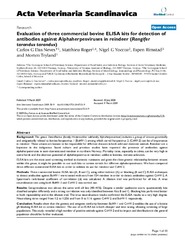| dc.contributor.author | Yoccoz, Nigel G. | |
| dc.contributor.author | Das Neves, Carlos G. | |
| dc.contributor.author | Roger, Matthieu | |
| dc.contributor.author | Rimstad, Espen | |
| dc.contributor.author | Tryland, Morten | |
| dc.date.accessioned | 2009-10-12T09:46:01Z | |
| dc.date.available | 2009-10-12T09:46:01Z | |
| dc.date.issued | 2009-03-09 | |
| dc.description.abstract | Background: The genus <i>Varicellovirus</i> (family <i>Herpesviridae</i> subfamily <i>Alphaherpesvirinae</i>) includes a group of viruses genetically
and antigenically related to bovine herpesvirus 1 (BoHV-1) among which cervid herpesvirus 2 (CvHV-2) can be of importance
in reindeer. These viruses are known to be responsible for different diseases in both wild and domestic animals. Reindeer are a
keystone in the indigenous Saami culture and previous studies have reported the presence of antibodies against
alphaherpesviruses in semi-domesticated reindeer in northern Norway. Mortality rates, especially in calves, can be very high in
some herds and the abortion potential of alphaherpesvirus in reindeer, unlike in bovines, remains unknown.
ELISA kits are the most used screening method in domestic ruminants and given the close genetic relationship between viruses
within this genus, it might be possible to use such kits to screen cervids for different alphaherpesviruses. We have compared
three different commercial ELISA kits in order to validate its use for reindeer and CvHV-2.
<br>
Methods: Three commercial bovine ELISA kits (A, B and C), using either indirect (A) or blocking (B and C) ELISA techniques
to detect antibodies against BoHV-1 were tested with sera from 154 reindeer in order to detect antibodies against CvHV-2. A
Spearman's rank-based coefficient of correlation (ρ) was calculated. A dilution trial was performed for all kits. A virus
neutralization test using both BoHV-1 and CvHV-2 was carried out.
<br>
Results: Seroprevalence was almost the same with all kits (40–41%). Despite a similar qualitative score, quantitatively kits
classified samples differently and a strong correlation was only identified between Kits B and C. Blocking kits performed better
in both repeatability and in the dilution trial. The virus neutralization results confirmed the ELISA results to a very high degree.
Neutralizing titres ranged from 1:2 to 1:256 and from 0 to 1:16 against CvHV-2 and BoHV-1 respectively.
<br>
Conclusion: Results show that the genetic and antigenic similarity between BoHV-1 and CvHV-2 enables the use of a bovine
gB blocking ELISA kit to screen reindeer. The use of an ELISA kit is both cheaper and time saving, allowing screening of large
populations. This study revealed a high number of positive animals against CvHV-2 and its impact and distribution in the general
population should be further evaluated. | en |
| dc.format.extent | 867668 bytes | |
| dc.format.mimetype | application/pdf | |
| dc.identifier.citation | Acta Veterinaria Scandinavica 2009, 51:9 | en |
| dc.identifier.uri | https://hdl.handle.net/10037/2173 | |
| dc.identifier.urn | URN:NBN:no-uit_munin_1925 | |
| dc.language.iso | eng | en |
| dc.publisher | BioMed Central | en |
| dc.rights.accessRights | openAccess | |
| dc.subject | VDP::Mathematics and natural science: 400::Basic biosciences: 470::General immunology: 478 | en |
| dc.title | Evaluation of three commercial bovine ELISA kits for detection of
antibodies against Alphaherpesviruses in reindeer (Rangifer
tarandus tarandus) | en |
| dc.type | Journal article | en |
| dc.type | Tidsskriftartikkel | en |
| dc.type | Peer reviewed | en |


 English
English norsk
norsk